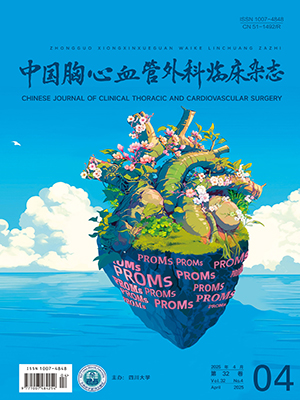| 1. |
Adler Y, Charron P, Imazio M, et al. 2015 ESC Guidelines for the diagnosis and management of pericardial diseases: The Task Force for the Diagnosis and Management of Pericardial Diseases of the European Society of Cardiology (ESC) Endorsed by: The European Association for Cardio-Thoracic Surgery (EACTS). Eur Heart J, 2015, 36(42): 2921-2964.
|
| 2. |
Angelini GD, Penny WJ, el-Ghamary F, et al. The incidence and significance of early pericardial effusion after open heart surgery. Eur J Cardiothorac Surg, 1987, 1(3): 165-168.
|
| 3. |
Ege T, Tatli E, Canbaz S, et al. The importance of intrapericardial drain selection in cardiac surgery. Chest, 2004, 126(5): 1559-1562.
|
| 4. |
马丹, 杨梅, 樊骏, 等. 胸腔镜肺叶切除术后引流管管径对患者舒适度影响的前瞻性队列研究. 中国胸心血管外科临床杂志, 2015, 22(10): 928-931.
|
| 5. |
Mueller XM, Tinguely F, Tevaearai HT, et al. Impact of duration of chest tube drainage on pain after cardiac surgery. Eur J Cardiothorac Surg, 2000, 18(5): 570-574.
|
| 6. |
Alec V, Ottavio A, Felicita A, et al. Guidelines on the management of valvular heart disease (version 2012). Eur Heart J, 2012, 33(19): 2451-2496.
|
| 7. |
Mirmohammad-Sadeghi M, Pourazari P, Akbari M. Comparison consequences of Jackson-Pratt drain versus chest tube after coronary artery bypass grafting: A randomized controlled clinical trial. J Res Med Sci, 2017, 22: 134.
|
| 8. |
Ljungqvist O, Scott M, Fearon KC. Enhanced recovery after Surgery: A review. JAMA Surg, 2017, 152(3): 292-298.
|
| 9. |
Moss E, Miller CS, Jensen H, et al. A randomized trial of early versus delayed mediastinal drain removal after cardiac surgery using silastic and conventional tubes. Interact Cardiovasc Thorac Surg, 2013, 17(1): 110-115.
|
| 10. |
车国卫, 李为民, 刘伦旭. 快速肺康复需要围手术期流程优化. 中国胸心血管外科临床杂志, 2016, 23(3): 216-220.
|
| 11. |
中华医学会肠外肠内营养学分会加速康复外科写作组. 结直肠手术应用加速康复外科中国专家共识(2015版). 中国实用外科杂志, 2015, 35(8): 841-843.
|
| 12. |
Engelman RM, Rousou JA, Flack JE 3rd, et al. Fast-track recovery of the coronary bypass patient. Ann Thorac Surg, 1994, 58(6): 1742-1746.
|
| 13. |
Krzych Ł, Kucewicz-Czech E. It is time for enhanced recovery after surgery in cardiac surgery. Kardiol Pol, 2017, 75(5): 415-420.
|
| 14. |
Li M, Zhang J, Gan TJ, et al. Enhanced recovery after surgery pathway for patients undergoing cardiac surgery: a randomized clinical trial. Eur J Cardiothorac Surg, 2018, [Epub ahead of print].
|
| 15. |
Gercekoglu H, Aydin NB, Dagdeviren B, et al. Effect of timing of chest tube removal on development of pericardial effusion following cardiac surgery. J Card Surg, 2003, 18(3): 217-224.
|




